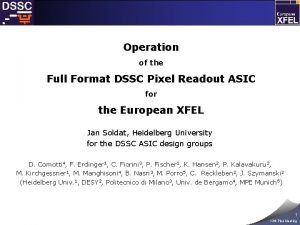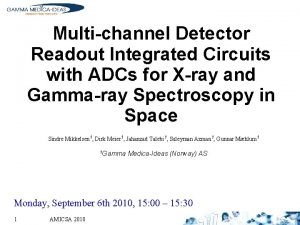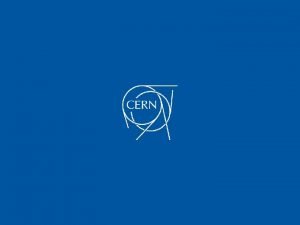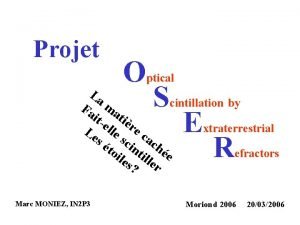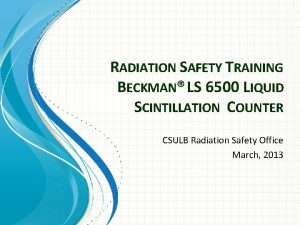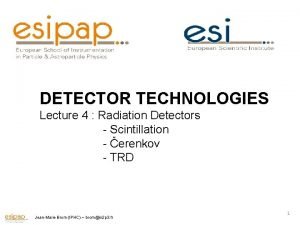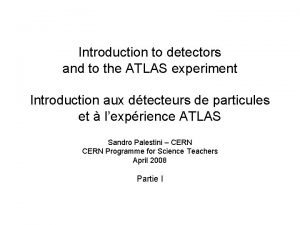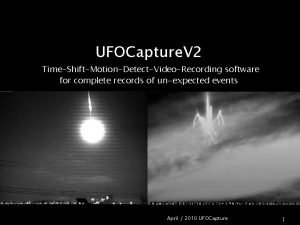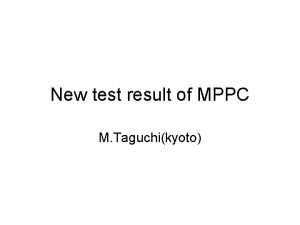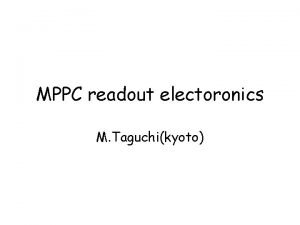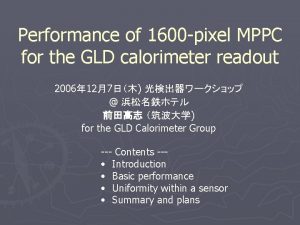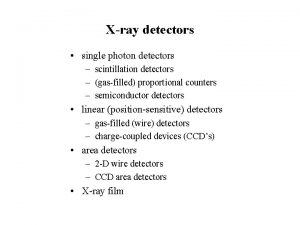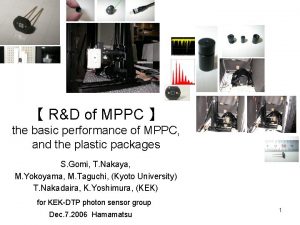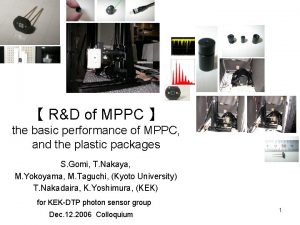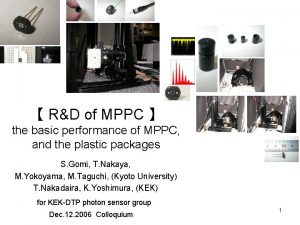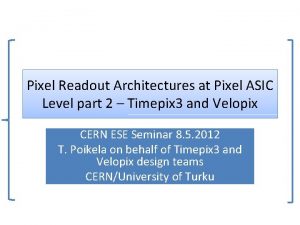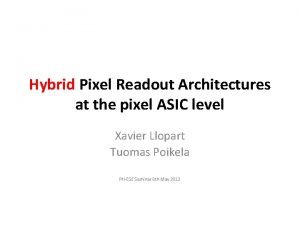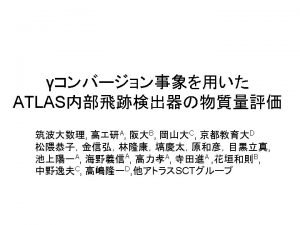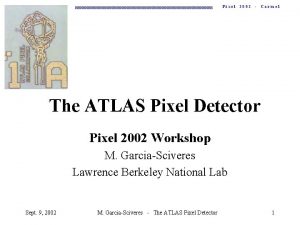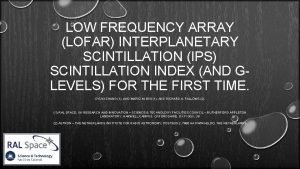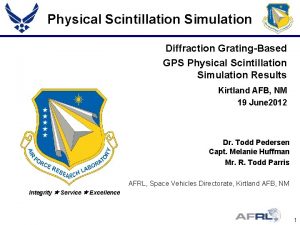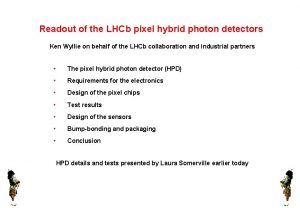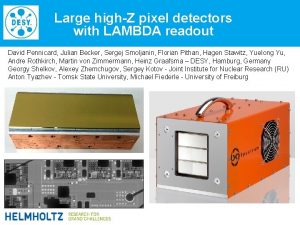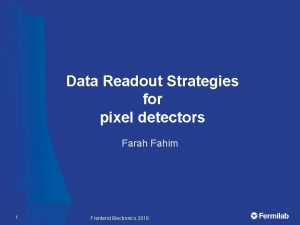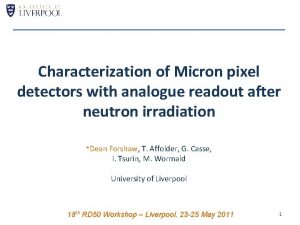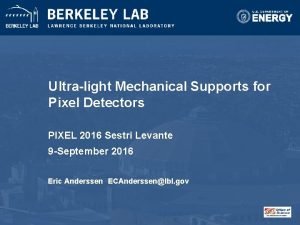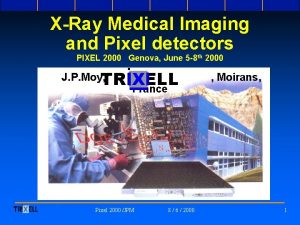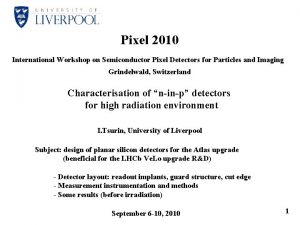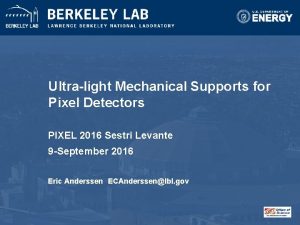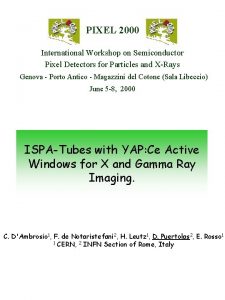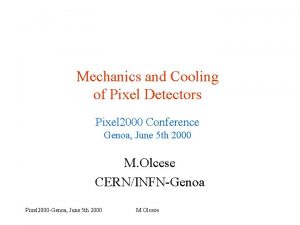PERFORMANCE OF SCINTILLATION PIXEL DETECTORS WITH MPPC READOUT























![Ce. Br 3 scintillator Crystal/Property Ce. Br 3 LYSO Density [gcm-3 ] 5. 10 Ce. Br 3 scintillator Crystal/Property Ce. Br 3 LYSO Density [gcm-3 ] 5. 10](https://slidetodoc.com/presentation_image/35f2aff4d2e1412d3a8ef2f0874950cb/image-24.jpg)

- Slides: 25

PERFORMANCE OF SCINTILLATION PIXEL DETECTORS WITH MPPC READ-OUT AND DIGITAL SIGNAL PROCESSING Mihael Makek with D. Bosnar, V. Gačić, L. Pavelić, P. Šenjug and P. Žugec Department of Physics Faculty of Science, University of Zagreb 2 nd Jagiellonian Symposium on Fundamental and Applied Subatomic Pysics, Krakow, 2017

Motivation and outline Construct and test segmented detector arrays using state-ofthe art Si. PMs, scintillation materials and digital signal processing electronics; applications: PET, PALS, fundamental measurements Outline Simulation of detector efficiencies Experimental setup Performance results of LFS scintillator pixels and MPPC array Krakow, 2017 Mihael Makek 2

Simulation of ideal detection efficiency takes into account: density, Zeff, resolution Geant 4, geometry: 8 x 8 pixels, g impinging on either of 4 central pixels Showing fraction of detected/incoming 511 ke. V gammas Detector Edep. >50 ke. V Edep. ~511 ke. V Single 0. 59 0. 46 Coincidence 0. 35 0. 21 LFS 20 mm Detector Edep. >50 ke. V Edep. ~511 ke. V Single 0. 57 0. 43 Coincidence 0. 32 0. 18 LYSO 20 mm Krakow, 2017 Mihael Makek 3

LFS scintillator Lutetium Fine Silicate (Zecotec patent) Crystal/Property 4 x 4 array LFS LYSO 7. 35 7. 1 64 66 Atten. Length [cm] 1. 15 1. 12 Decay constant [ns] <33 41 Max. emission [nm] 425 Light yield [% Na. I] 80 -85 70 -80 1. 81 Hygroscopic No No Active Yes x -33. 14 Density 3. 14 [gcm ] x 20 3 Zeff mm Refractive index Krakow, 2017 1 layer~0. 06 mm Mihael Makek 420 4

MPPC arrays 4 x 4 MPPC array (S 13361‐ 3050 AE Hamamatsu) Main features: Number of micro-cells 3584/pixel Micro-cell pitch = 50 mm Fill factor 74% Epoxy window, n=1. 55 Vbr ~ 53 V 1 p. e. PDE (typical) ~ 40% 2 p. e. Spectral range 320 -900 nm 3 p. e. (max at 450 nm) Krakow, 2017 Mihael Makek 5

Amplifiers 16 -channel Passive base: selectable cable length Matching base depending on the Si. PM model and manufacturer Sum output with selectable gain and offset Output signals: 50 Ohm maximum -2 V Rise-time ~ 10 -15 ns (depending on cable length) Krakow, 2017 Mihael Makek 6

Digitizers CAEN model V 1743 16 channel, switched capacitor (based on SAMLONG chip) 1024 samples/channel 7 events/channel buffer Up to 3. 2 GHz sampling rate Selectable trigger logic (after bugfixes on our request) Multi-board synchronization still in experimental phase Individual readout for all crystal channles Krakow, 2017 Mihael Makek 7

Setup and trigger 16 ch. Amp. 16 ch. digitizer 16 ch. Amp. 22 Na OR TRG IN Krakow, 2017 OR AND Mihael Makek 16 ch. digitizer TRG IN 8

Digitized signals Recorded at 1. 6 GHz 625 ps samples Vop = Vbr+1. 5 V Rise-time ~ 15 ns Energy reconstruction: a) Amplitude b) Integral Krakow, 2017 Mihael Makek 9

Reconstructed energy of 511 ke. V gammas DE/E=15% DE/E=13% Integral linear with amplitude Integral provides superior energy resolution Krakow, 2017 Mihael Makek 10

Non-linearity correction Limited number of micro-cells causes saturation of large signals The relation between incident photons (Nph)and fired cells (Nfired): M is the total number of micro-cells, PDE is photon detection efficiency calculated as product of QE(l), Pav (V, T) and fill factor Apply correction: Original Corrected where Nfired is obtained empirically: Krakow, 2017 201 ke. V from 176 Lu 306 ke. V from 176 Lu Mihael Makek 511 ke. V from 22 Na 11

Light sharing Calibration: sum of all fired channels = 511 ke. V Light sharing significant bewteen adjacent pixels. 0, 06 mm reflector too thin! Single pixel energy resolution degradation @511 ke. V: 11% 13% Energy deposition: Leading/total ~ 80% S 1 st neighbors/total ~ 20% 2 nd neighors/total ~ negligible Krakow, 2017 Mihael Makek 12

One photo-electon amplitude Measured on oscilloscope Map temperature and voltage dependence for both detectors Vbr(1) = 52. 1 V Vbr(2) = 52. 2 V Krakow, 2017 Mihael Makek 13

Number of fired micro-cells @511 ke. V Mean number of fired cells at 511 ke. V vs: Voltage Temperature Reflects how PDE changes with temperature and voltage Impact on energy resolution Krakow, 2017 Mihael Makek 14

511 ke. V photo-peak amplitude Mean amplitude of the 511 ke. V photo-peak vs V and t (Range limited by amplifier gain) Change of amplitude with V is ~equally governed by number of fired cells and 1 p. e. amplitude Change of amplitude with temp. is dominantly governed by 1 p. e. amplitude Krakow, 2017 Mihael Makek 15

Energy resolution @ 511 ke. V Energy resolution improves with U in the measured range Negligible dependence on temperature in the measured range Krakow, 2017 Mihael Makek 16

Time resolution Pixel-to-pixel timing Determined by fitting a straight line to the signal rising – edge Dt ~1. 6 ns (FWHM) Limited by amplifier rise-time of ~15 ns Krakow, 2017 Mihael Makek 17

Summary Simulation shows LFS has potential to improve sensitivity of PET compared to LYSO LFS performace tests: energy resolution satisfactory, but can improve by reducing the light sharing between the pixels and running at higher overvoltage Time resolution must be checked with fast preamplifier MPPC arrays show stable performance Saturation correction done on event-by-event basis Signal amplitudes scale linearly with voltage and temperature Temperature variations under control without direct compensation Krakow, 2017 Mihael Makek 18

BACKUP SLIDES Krakow, 2017 Mihael Makek 19

Single pixel full spectrum Krakow, 2017 Mihael Makek 20

Energy calibration procedure 1) 2) 3) 4) Correct each channel for non-linearity (event-by-event) Equilibrate all channels by scaling each channel’s photo-peak to the same value Calibrate the sum of all fired channels to 511 ke. V Repeat procedure for each run (approx 1 h of data taking) The self-calibration on coincidence data is stable wrt to temperature and voltage change no need to pre-calibrate the setup Krakow, 2017 Mihael Makek 21

Uniformity of the response with distance from the MPPC A modified detector setup to test the uniformity: 20 mm Pb collimator d 5 d 4 d 3 d 2 d 1 22 Na MPPC Krakow, 2017 Mihael Makek 22

Uniformity of the response with distance from the MPPC Select photo-peak in the leading pixel Leading pixel amplitude vs. distance Leading/(sum of 1 st neighbors) vs. distance Homogeneous response! Krakow, 2017 Mihael Makek 23
![Ce Br 3 scintillator CrystalProperty Ce Br 3 LYSO Density gcm3 5 10 Ce. Br 3 scintillator Crystal/Property Ce. Br 3 LYSO Density [gcm-3 ] 5. 10](https://slidetodoc.com/presentation_image/35f2aff4d2e1412d3a8ef2f0874950cb/image-24.jpg)
Ce. Br 3 scintillator Crystal/Property Ce. Br 3 LYSO Density [gcm-3 ] 5. 10 7. 1 Zeff 45. 9 66 Decay constant [ns] 20 41 Max. emission [nm] 380 420 Light yield [% Na. I] 160 70 -80 Refractive index 2. 09 1. 81 Hygroscopic Yes No Active Low Yes Surface Fine ground Polished Krakow, 2017 Mihael Makek 24

Simulation of ideal detection efficiency takes into account: density, Zeff, resolution Geant 4, geometry: 8 x 8 pixels, g impinging on either of 4 central pixels Showing fraction of detected/incoming 511 ke. V gammas Detector Edep. >50 ke. V Edep. ~511 ke. V Single 0. 45 0. 21 Coincidence 0. 20 0. 04 Ce. Br 3 20 mm Detector Edep. >50 ke. V Edep. ~511 ke. V Single 0. 57 0. 43 Coincidence 0. 32 0. 18 LYSO 20 mm Krakow, 2017 Mihael Makek 25
 Full pixel readout
Full pixel readout Readout device
Readout device Readout integrated circuit
Readout integrated circuit Readout units
Readout units Cintillate
Cintillate Beckman ls6500 liquid scintillation counter
Beckman ls6500 liquid scintillation counter Scintillation
Scintillation Scintillation detector technologies
Scintillation detector technologies Scintillation liquide
Scintillation liquide Ufocapture
Ufocapture Scintillation
Scintillation Mppc
Mppc Multi product process chart
Multi product process chart Mppc
Mppc Rancangan produk rancangan proses dan rancangan skedul
Rancangan produk rancangan proses dan rancangan skedul 1600 pixel
1600 pixel Feature detectors ap psychology
Feature detectors ap psychology Giant wave detectors murmurs universe
Giant wave detectors murmurs universe Yodsawalai chodpathumwan
Yodsawalai chodpathumwan Photo detectors
Photo detectors Rhmd: evasion-resilient hardware malware detectors
Rhmd: evasion-resilient hardware malware detectors Gravitational wave detectors hear murmurs from
Gravitational wave detectors hear murmurs from Photo detectors
Photo detectors Nuclear detectors
Nuclear detectors Feature detectors
Feature detectors What is streaming potential
What is streaming potential
